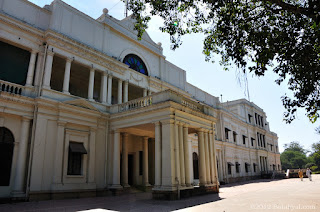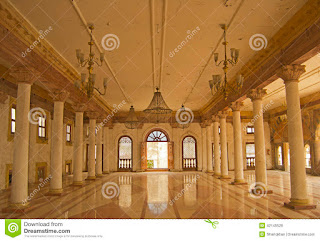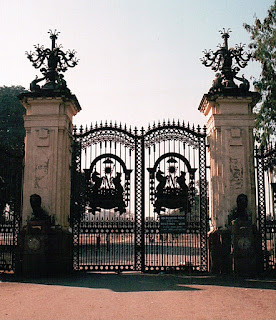== |
| Lal Bagh palace,Indore, metheney.net |
The Lal Bagh Palace in Indore stands as one of the city's most spectacular historical buildings, a sprawling monument to the highly Westernized taste and wealth of the Holkar royal family, who ruled the Maratha princely state of Indore. Situated on the outskirts of the town on the banks of the River Khan, the palace complex covers an expansive area of 28 acres of land and gardens, reflecting the grandeur necessary for a royal household that commanded a rare high rank as a 19-Gun Salute state. The construction of this massive structure, which was carried out in three major phases, began in 1886 under the tenure of Maharaja Tukoji Rao Holkar II, and was finally completed in 1921 under his successor, who was also named Tukoji Rao Holkar II.
The architecture of the palace is an impressive blend of European styles, incorporating elements of Renaissance, Palladian, and Baroque movements, showcasing the Holkar family’s sensitivity to aesthetic values that transcended regional boundaries. This opulent style was necessary given the palace's primary function as a venue for hosting grand events, including numerous royal receptions for British rulers and meetings with important personalities of the kingdom. The magnificent entrance gates immediately set a tone of majesty, as they were deliberately modeled after the gates of Buckingham Palace in London. These cast iron gates, proudly carrying the distinctive emblem of the Royal Holkar family, were actually forged in London and then meticulously shipped to Indore before being assembled on site, a testament to the expense and effort invested in the palace.
The Lal Bagh Palace is a three-story marvel whose interior spaces are lavishly detailed. Upon entering, visitors are greeted by a ground-floor entrance hall crafted entirely from exquisite Italian marble. Throughout the rooms and halls, one finds a recurring theme of European splendor, enhanced by impressive chandeliers, Italian marble columns, and Belgian stained glass windows that bathe the interiors in colored light. Among the unique features that enhance the splendor of the palace is the ballroom, which boasts a specially designed spring-mounted floor intended to provide extra bounce for dancing, a clear nod to European aristocratic entertainment. Other lavish decorative elements include fine Persian carpets and preserved curiosities such as stuffed tigers. The bedrooms of the royal family themselves are rich in glass and Sheesham wood, further contributing to the highly embellished atmosphere.
 |
Interior Lalbagh Palace, Indore architecturaldigest.in
|
 |
| Lal Bagh Palace, Indore architecturaldigest.in |
 |
Darbar hall, Lal Bagh, Indore dreamstime.com
|
 |
Lal Bagh Palace,Indore,MP worldtravelserver.com
|
The palace complex saw through the reigns of three successive princes, from Maharajah Tukoji Rao, who began the vision, to Maharajah Shivaji Rao, and finally to Maharajah Tukoji Rao II. Although Tukoji Rao II abdicated his power in 1926, he notably chose to remain in the palace until his death in 1978. In addition to its grand residential and ceremonial halls, the palace houses a fascinating historical collection on its first floor, comprising various coins minted during the Muslim period of Indian history. Among the most unusual operational aspects of the complex is the palace kitchen, which was located on the other side of the river near Gopal Bagh. It was accessed via a specially constructed,
well-lit underground tunnel, ensuring the smooth and private transportation of food to the royal family and their guests. The entire complex, which stood as a symbol of princely independence until Indore State acceded to the Union of India, also includes several sacred shrines present within the palace grounds














